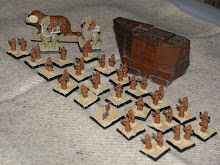I've been quite busy making a variety of bits of pieces of late, but have been rather slack in actually posting anything. A while back, I started work on some cardboard M-113s (click
here if you want to know more)
 |
| A mixture of Bravo Team ready mades (at rear), Esci (unpainted front left), and cardboard model M-113s |
The Esci kit was missing a few key pieces that I replaced using the usual methods of bodging out of plastic card, or finding something about right in the bits box.
 |
| One of those road wheels is not like the others..... |
 |
| A wheel and tire from a jeep or light truck is given a outer ring of plastic card in order to make a new road wheel. |
 |
| The green hatch is a spare from the Airfix M-113 Fire Support Vehicle kit. |
I still have three more of the Esci kits to build, and I plan to build them as the straight APC version without any additional stowage. With the cardboard models, I have tried to add clutter and stowage to the vehicles in order to try and disguise any shortcomings in the models, and to see if I could pass them off as vehicles used by support elements, rather than teeth elements, while still maintaining flexibility to use them as such as needed.
 |
| Esci vs. Cardboard. |
I don't think I have really succeeded in doing this - at best I have made three M-113s that have a certain air of clutter to them. I suspect I need to put more stowage on them, and/or items of auxiliary equipment that will earmark the vehicle into a support role.
 |
| Needs more stowage..... |
 |
| And the tracks aren't quite right.... |
 |
| I could have put more effort into the rear doors, but I figured this was good enough... |
On the cardboard front I have benefited from the generosity of Paul from Plastic Warriors sending me three rather nice scratch-built APCs (click
here for details)
 |
| Esci vs Cardboard part II. |
Now for my purposes, these M-113s from Paul being a little large is not a problem, as an imagination background allows for the creation of plausible back stories that can explain away a number of sins.
The fact that there existed earlier APCs, such as the M-75 and the M-44 (click
here for details). that were somewhat larger than the M-113, makes it easier to declare these to be a hitherto unknown vehicle of a similar ilk.
 |
| Spot the Esci! |
That, or field them in force with no other M-113s!





















































